Take a break from the crowds of Venice, and feast on a slice of old-world Italy, then head out to the Islands of the Venetian Lagoon. A half-hour boat ride away from Venice lies Burano, an island rich in traditional life. Pack your fancy camera along because this place is a photographer's paradise...
Many people have heard of Murano, the island made famous by stained glass factories. While Murano is fascinating, it is super touristy and is overcrowded with tour groups, especially during cruise ship season. If you want a scenic island with fewer crowds, the sleepy fishing village of Burano is your island. In recent years, tiny Burano has gained a lot of tourist attention as well, and you'll see why.
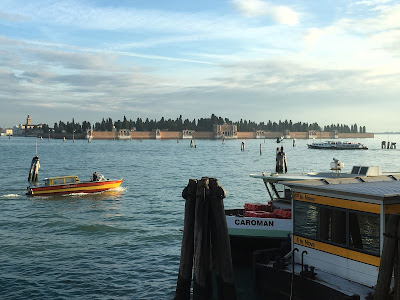 |
| Fondamente Nova Vaporetto Station |
Part of the fun of going out to the islands around Venice is the short and scenic boat cruise on a Vaporetto, a Venetian water bus. Catch the Vaporetto at the "Fondemente Nova" Vaporetto station. Line #12 takes you to Murano, Burano, then the deserted island of Torcello. You can purchase tickets to Burano from Fondemente Nova from the conductor on board the Vaporetto as we did, from tickets booths located at some of the Vaporetto docks around town or from the VèneziaUnica offices around Venice.
TIP: IF YOU PURCHASE A ONE-DAY PASS, IT ALLOWS YOU TO USE THE TICKET ON ANY VAPORETTO LINE FOR 24 HOURS. Just hold up your electronic reusable ticket to the little white machine at the dock before you board. When you hear a "beep," you're good to go aboard.
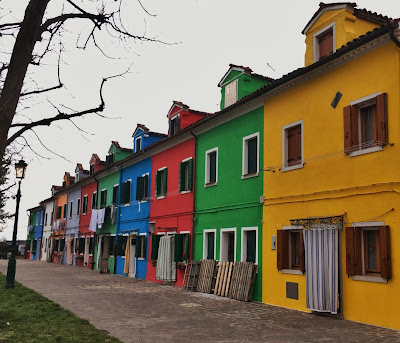 |
| Colour-FULL Houses of Buran |
Burano is actually a group of four small islands separated by canals and connected with bridges. The population of Burano is only about 3,000 people, and the locals don't consider themselves Venetian; they are proud Buranelli. In fact, Burano was never under the Venetian authority but rather that of Torcello, which is the island next door. Burano is now famous for two things; vividly painted houses and exquisite lace.
The houses on Burano have been brightly painted for centuries, since the "golden age" when Burano was a lace-making capital. The house colours are determined by a specific traditional colouring system. If a house owner wants to change their house colour, they must first ask permission of the local government, who will then tell the owner what colour choices are allowed for that particular property.
Wandering around Burano is a joy; even in the middle of winter, the bright houses liven up the dull skies. TIP: Burano suffers significantly during the Aqua Alta or high water flooding that occurs in the Venetian lagoon each winter, so keep that in mind if planning your visit to Burano when it's high-water. But there is more to Burano than pretty houses, and that is...Burano lace!
It is said the women of Burano began making lace with needles because they were constantly fixing the fishing nets that required repair, but that may be an old myth. It's more likely that making lace with needles was brought to the Venitian lagoon by way of Cypress, which was part of the Venetian Empire.
 |
| Lace Shop In Burano |
What is not a myth is that by the Renaissance, Burano lace was so popular and sought after that Royals like Richard the III, Mary Tudor, and King Louis XIV had wardrobes packed with garments made with Burano lace. Burano's lace was so sought after it was being smuggled out of Venice by many dubious methods, including tricks like hiding lace in baby's diapers or stuffed into coffins (sometimes with the corpses in them still). WOW, lace traffickers in 1600's-who knew! The whole island of Burano was one giant lace-making factory that could not keep up with popular demands. There are 7 different types of stitches and 5 separate stages of making a Burano lace piece. Each lacemaker was assigned to a specific stitch or task, even if they knew how to do all the required stitches. In this way, the women could work in an assembly line and produce as many lace pieces as possible.
 |
| Expert Lace Makers |
Handmade lace demands declined with the demise of the Venetian empire and the industrialization of lace making. Fortunately, the lace-making tradition survived on in Burano, and Queen Margherita of Italy (yes, like the pizza) wore a gorgeous wedding dress trimmed in Burano lace, reviving the fashion trend of handmade Burano lace. A lace-making school in Burano was established in 1872 after the Royal wedding to preserve the craft of handmade lace. Unfortunately, the demand for handmade lace declined again, and the school closed in 1970. The former school building in Burano's main Piazza Galuppi now houses the Burano Lace Museum, displaying Italy's Queen Margheritas' wedding dress.
 |
| San Martino |
TIP: If you miss the Lace Museum (it was closed when we visited Burano), you can still see gorgeous lace pieces dating back to the 15th century at: Dalla Lidia Merletti d'Arte on Via Galuppi. This bright, beautiful shop houses the most stunning pieces of Burano handmade lace on the island. At the back of the shop, there is an extensive private collection of historic lace. There are lace artisans on-site working in the shop and videos of the lace-making process so you can see how delicate and precise the lace artwork is. WARNING! Most of the lace sold in Burano shops is made in factories or imported from places like China. Do your research and buy from trusted sources. TIP: BURANO LACE IS COSTLY! For example, I purchased a set of Venetian lace runners (about half the size of a placemat) for my bedroom nightstands, and they set me back €60 EACH! This was not even BURANO LACE, it was VENETIAN LACE, an entirely different style of lace, but the pieces are exquisite. Here's how I look at it; you are investing in a time-honoured handicraft that may be non-existent in the next few decades. The shop owner at Dalla Lidia (a lace artisan herself) is an expert on the different types of laces and is so helpful in answering any questions you may have. If you want a unique souvenir from Burano or an heirloom gift for someone special...Dalla Lidia is my vote for the place to go for quality lace.
Towering over Piazza Galuppi is Burano's leaning 16th-century bell tower of San Martino. Inside the church, you will find a 1725 painting by the Venetian Master Tiepolo called "Cavalry," which is definitely worth a peek inside.
 |
| Fishing Boats In Burano |
 |
| Alfresco Dining In January |
If you get hungry, Burano is a great place to eat. The seafood is always fresh, and the prices are low compared to a meal in Venice. TIP: If you want a quick snack, try a "cono di fritto Misto," which is deep-fried mixed seafood served in a paper cone. We were there too late in the afternoon, and many snack shops were sold out of fish for the day. Remember, the fish is caught fresh every morning!
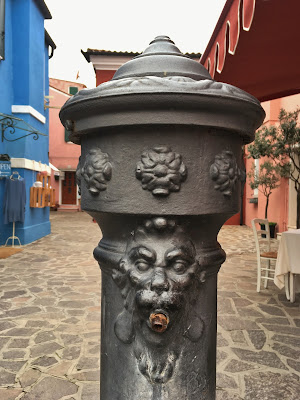 |
| Fountain On Burano |
If you want a sweet treat after your meal, check out the bakeries in Burano that specialize in traditional cookies like Bussolà Buranello-a rich egg & butter cookie with a hint of lemon in the shape of an "o." Bussolà means compass in Italian, and these cookies were eaten by the fishermen while they were out on their boats. Esse are "s" shaped cookies made from the same dough. Pevarini are a Venetian cookie with black pepper and sweetened with molasses. These cookies date back to the 1400s when pepper was brought back to Venice from the East. Then there are the Zaeti Veneti which is another traditional Venetian cookie made with cornflour and raisins...Nonna's have been making these in Venice since the 1500s!
When it comes to dinner, a great time to be in Burano is in the late afternoon when the crowds have returned to Venice, and the locals come out to relax and be social. Why not stay for dinner and take some photos that are not jam-packed with tourists? There are many good restaurants in Burano to choose from, all specializing in the catch of the day. You can take your time, sip some wine and watch the sun sink into the lagoon.
For more information on Burano, check out the Burano tourism website and enjoy your visit!
Venice and its surrounding lagoon communities are changing rapidly in the 21st century, especially with the onset of mass tourism due to the many cruise ships docking in the lagoon. Small islands like Burano that in the past relied on fishing and lace-making but now rely on tourists are on what I call the "culturally endangered destination" list. When visiting places like Burano, support the local businesses and artisans to keep the local culture alive for future generations of travellers to discover and appreciate.
Follow me on INSTAGRAM and FACEBOOK for daily photos!








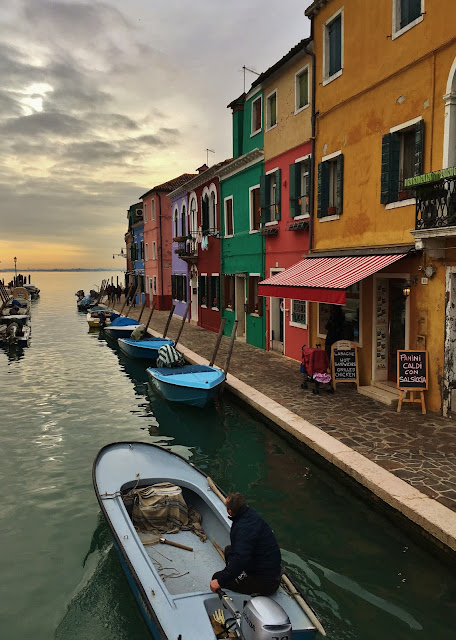
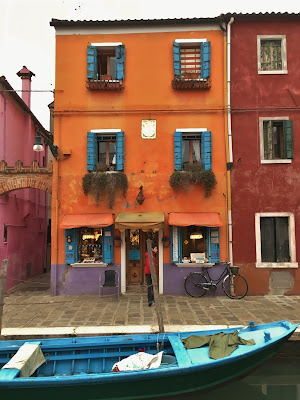
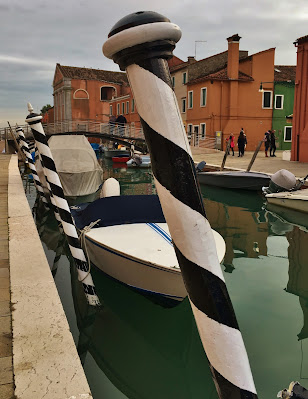
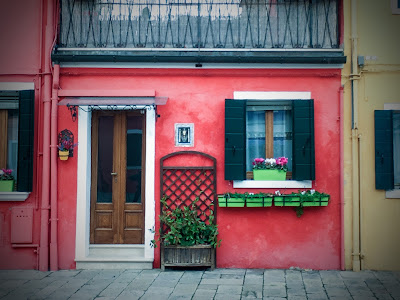

No comments:
Post a Comment